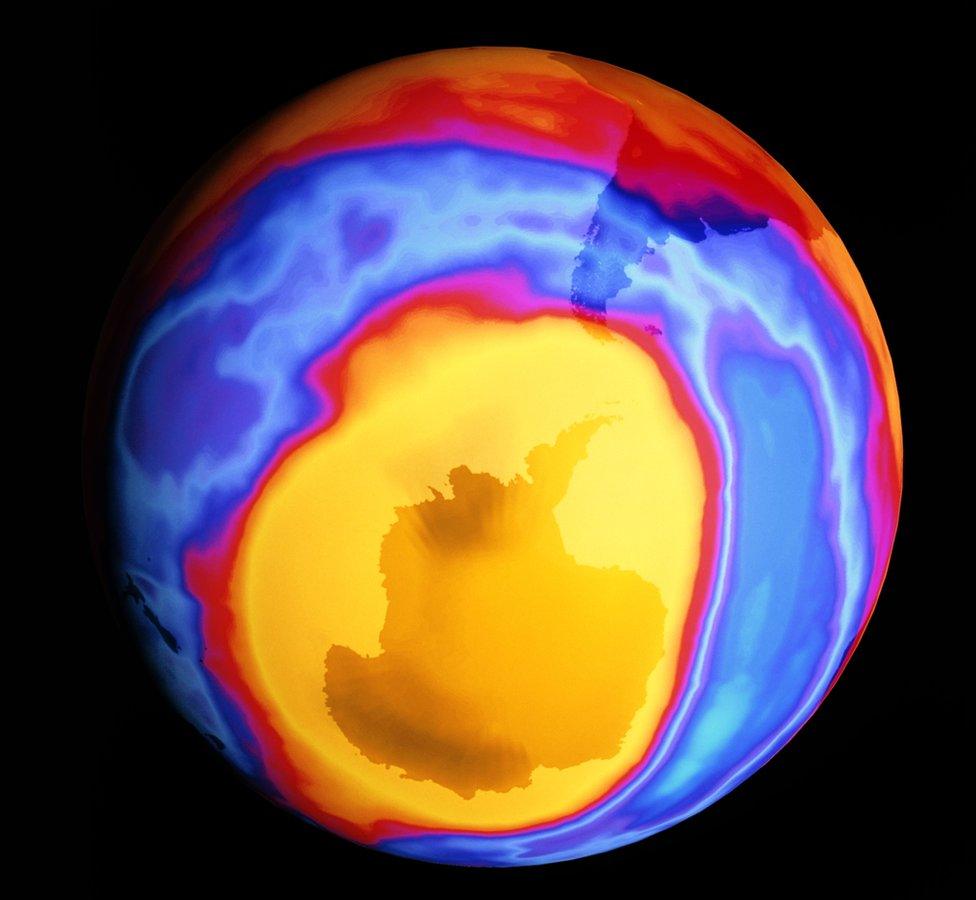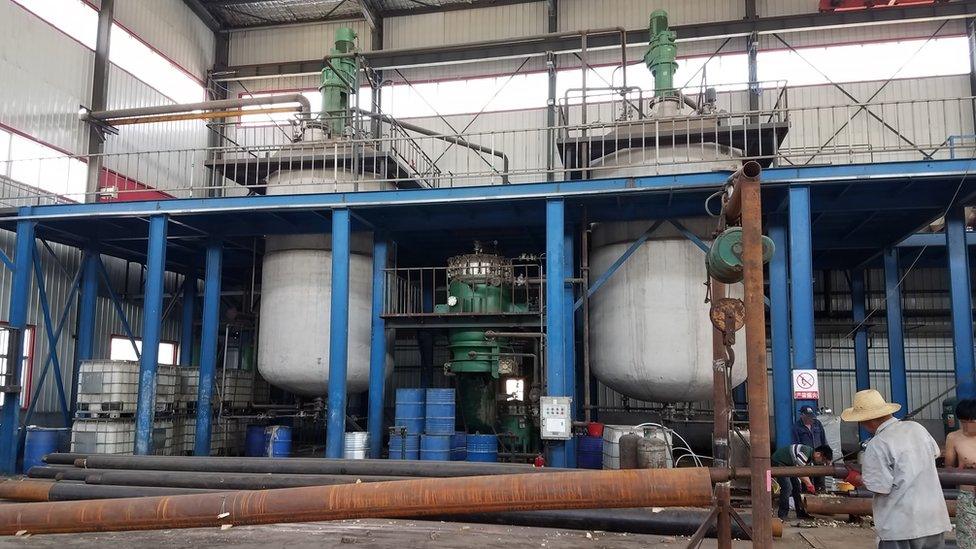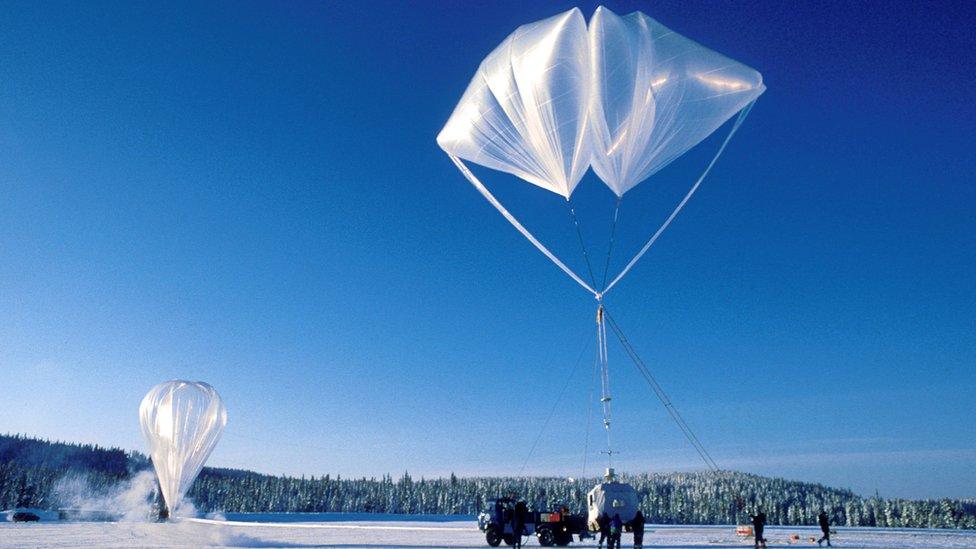Ozone hole mystery: China insulating chemical said to be source of rise
- Published

The ozone hole over Antarctica in the year 2000
Cut-price Chinese home insulation is being blamed for a massive rise in emissions of a gas, highly damaging to the Earth's protective ozone layer.
The Environmental Investigations Agency (EIA) found widespread use of CFC-11 in China, even though the chemical was fully banned back in 2010.
Scientists have been extremely puzzled by the mysterious rise in emissions.
But this report, external suggests the key source is China's home construction industry.
Just two months ago, researchers published a study showing that the expected decline in the use of CFC-11 after it was completely banned eight years ago had slowed to a crawl.
There were suspicions among researchers that new supplies were being made somewhere in East Asia.
Rumours were rife as to the source. There was a concern among some experts that the chemical was being used to secretly enrich uranium for use in nuclear weapons.
The reality it seems is more about insulation than proliferation.
CFC-11 makes a very efficient "blowing agent" for polyurethane foam, helping it to expand into rigid thermal insulation that's used in houses to cut energy bills and reduce carbon emissions.
Researchers from the EIA, a green campaign group, contacted foam manufacturing factories in 10 different provinces across China. From their detailed discussions with executives in 18 companies, the investigators concluded that the chemical is used in the majority of the polyurethane insulation the firms produce.
One seller of CFC-11 estimated that 70% of China's domestic sales used the illegal gas. The reason is quite simple - CFC-11 is better quality and much cheaper than the alternatives.

Barrels of chemicals seen by investigators in China which contain CFC-11
The authorities have banned CFC-11 but enforcement of the regulation is poor.
"We were absolutely gobsmacked to find that companies very openly confirmed using CFC-11 while acknowledging it was illegal," Avipsa Mahapatra from EIA told BBC News.
"The fact that they were so blasé about it, the fact that they told us very openly how pervasive it is in the market, these were shocking findings for us."
The EIA says that its estimates of the amount of the gas being used in China are in the middle of the emissions range calculated by scientists in their report in May.
The scientist who first highlighted the problem with CFC-11 said the EIA findings seemed plausible, although it was difficult to be definitive.
Dr Stephen Montzka from the US National Oceanic and Atmospheric Administration (Noaa) told BBC News: "The pervasiveness of the use of CFC-11 that seems apparent in China based on their survey is quite amazing, although it is hard for me to assess the accuracy of the emission estimate they make to know if it is indeed likely that this activity can explain all or most of what we are observing in the global atmosphere."
So why is this important?
This is a big deal because of the amount of the dodgy chemical being used and its potential to reverse the healing that's starting to take place in the ozone layer.
China's polyurethane foam makes up about one-third of global production, so if they are predominantly using an ozone-depleting substance it will set back the closing of the ozone hole by a decade or more.
As well as the ozone layer, CFC-11 has a warming impact. Researchers estimate that if the use of the chemical continues, it would be the equivalent of CO₂ from 16 coal-fired power stations every year!
What can be done about this?
As China is a signatory of the Montreal Protocol, external that governs the use of ozone-depleting substances, it should be possible to put trade sanctions in place. However, since the protocol was signed in 1987, this weapon of last resort has never been used and it's not expected in this case.

A factory in China that told EIA that 99% of its products contained CFC-11
What's more likely is that China will be encouraged to crack down on the production of CFC-11s and to launch a full-scale investigation with the support of the Montreal Protocol secretariat.
"It is critical for the government of China not to treat these as isolated incidents," said Avipsa Mahapatra from the EIA.
"We want them to clamp down but it's supremely important for them to carry out a comprehensive investigation into the sector. It has to result in seizures, it has to result in arrests so that people know there are harsh penalties for the production of CFC-11."
Delegates to the Montreal Protocol are meeting this week in Vienna and they will try to come up with a plan to tackle the issue.
What is the ozone layer and why is it important?
Ozone is formed in the stratosphere some 15 to 30km above the surface of the Earth by the interaction of solar ultraviolet radiation with oxygen in the air. In this location, the newly formed ozone absorbs ultraviolet radiation, preventing most of it from reaching the ground. This is important because ultraviolet radiation can lead to skin cancer and eye damage in humans, can damage crops and marine life.
Remind me how the hole in ozone layer came about?
Scientists discovered in 1985, much to their surprise, that there was a 30% drop in ozone levels over Antarctica in October of that year. By 1992, the hole was as large as North America.

Researcher capturing air samples from the ozone layer above the Arctic
What was happening was that chemicals called chlorofluorocarbons contained in refrigeration, air conditioning, packaging, insulation, solvents, and aerosol propellants were releasing chlorine or bromine molecules when they were exposed to intense UV light in the stratosphere.
When chlorine and bromine atoms come into contact with ozone, they destroy the molecules. One chlorine atom can destroy over 100,000 ozone molecules before it is removed from the stratosphere. Ozone can be destroyed more quickly than it is naturally created.
So what did the world do about this?
For once, the world acted speedily and to good effect. Most nations, including the chemical industry, signed up to the Montreal Protocol which quickly banned most of the worst-offending chemicals. Developing countries were given much longer to replace the gases. So while most of the richer countries got rid of CFC-11 in the mid-1990s, China and others were expected to completely get rid of it in 2010. That obviously hasn't happened just yet.
I thought the ozone hole was recovering?
Back in 2014 researchers reported the first signs of a thickening in the ozone layer. At that point they said it would take a decade for the hole to start to shrink but by September 2015 scientists found that the hole was approximately 4 million sq km smaller than it was in the year 2000 - that's an area the size of India.
All this was due to the global phase out of CFCs. So it was a major surprise to ozone experts to find that the expected decline in these elements in the air had stalled. And now, according to the EIA, the reason behind the slowdown has been discovered - and it's mainly down to Chinese builders!